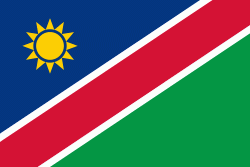Okahandja Constituency (Okahandja Constituency)
Okahandja Constituency is an electoral constituency in the Otjozondjupa Region of Namibia. It had 18,155 inhabitants in 2004 and 18,109 registered voters. The constituency consists of the town of Okahandja and the surrounding rural area.
The 2015 regional election was won by Steve Biko Booys of the SWAPO Party with 3,280 votes, followed by Sophia Basson of the Democratic Turnhalle Alliance (DTA) with 763 votes. Independent candidate Welfriedt Groeitjie Goaseb gained 501 votes.
The SWAPO candidate also won the 2020 regional election. Bethuel Tjaveondja received 2,451 votes, well ahead of Frisia Ambondja of the Independent Patriots for Change (IPC), a party formed in August 2020, who obtained 1,057 votes. There also ran Belinda Garoes of the United Democratic Front (UDF, 599 votes), Willem Veiko of the Popular Democratic Movement (PDM, the new name of the DTA, 350 votes), and Tjitee Mujoro of the Landless People's Movement (LPM, a new party registered in 2018, 332 votes).
The 2015 regional election was won by Steve Biko Booys of the SWAPO Party with 3,280 votes, followed by Sophia Basson of the Democratic Turnhalle Alliance (DTA) with 763 votes. Independent candidate Welfriedt Groeitjie Goaseb gained 501 votes.
The SWAPO candidate also won the 2020 regional election. Bethuel Tjaveondja received 2,451 votes, well ahead of Frisia Ambondja of the Independent Patriots for Change (IPC), a party formed in August 2020, who obtained 1,057 votes. There also ran Belinda Garoes of the United Democratic Front (UDF, 599 votes), Willem Veiko of the Popular Democratic Movement (PDM, the new name of the DTA, 350 votes), and Tjitee Mujoro of the Landless People's Movement (LPM, a new party registered in 2018, 332 votes).
Map - Okahandja Constituency (Okahandja Constituency)
Map
Country - Namibia
 |
 |
| Flag of Namibia | |
The driest country in sub-Saharan Africa, Namibia has been inhabited since pre-historic times by the San, Damara and Nama people. Around the 14th century, immigrating Bantu peoples arrived as part of the Bantu expansion. Since then, the Bantu groups, the largest being the Ovambo, have dominated the population of the country; since the late 19th century, they have constituted a majority. Today Namibia is one of the least densely populated countries in the world.
Currency / Language
| ISO | Currency | Symbol | Significant figures |
|---|---|---|---|
| NAD | Namibian dollar | $ | 2 |
| ZAR | South African rand | Rs | 2 |
| ISO | Language |
|---|---|
| AF | Afrikaans language |
| EN | English language |
| DE | German language |
| HZ | Herero language |















